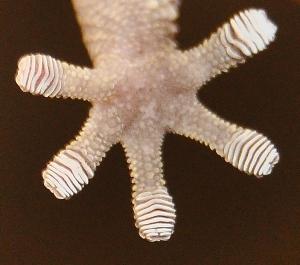Oct 16 2014
University of California biologists have discovered that geckos are able to smoothly climb downhill because of their ability to alter the orientation of their feet.
They selected the Chondrodactylus bibronii (gecko) for the research due to its preference for different habitats and as it does not have functional claws.
 This photo shows the underside of the gecko's foot. Underneath the toes are 'setae,' millions of very fine hair-like structures, which provide increased surface area and close contact between the foot and the surface on which it rests. The setae are curved inward, toward the center of the foot. When the gecko pulls back a toe, the setae get straightened. Credit: Emily Kane, UC Riverside.
This photo shows the underside of the gecko's foot. Underneath the toes are 'setae,' millions of very fine hair-like structures, which provide increased surface area and close contact between the foot and the surface on which it rests. The setae are curved inward, toward the center of the foot. When the gecko pulls back a toe, the setae get straightened. Credit: Emily Kane, UC Riverside.
Geckos are seen normally in warm areas globally and are known for the ability to scale steep smooth surfaces at ease. This is possible due to an adhesive system on their feet, more specifically their toes, which are equipped with numerous fine hair-like structures called "setae”. The setae provide increased surface area and close contact between the gecko’s foot and the surface on which it climbs. So far, the downhill locomotion of geckos has not been closely observed.
The university research revealed that during the downhill locomotion, the forelimbs of the geckos behave as brakes and increase friction by bearing down on the surface. The hind limbs tend to behave as stabilizers.
One of the biologists explained that the geckos adhesive system cannot be compared with Velcro as there are no suction cups. The adhesion rather happens due to intermolecular forces and shear force. The adhesion begins along the digit’s long axis, which helps to restrain the orientation of the foot during locomotion.
Prior to engaging its adhesive system, the gecko tends to curl its digits up when lifting its foot, uncurls them when pressing on a surface, and only then applies the adhesion. To release the adhesion effect, the gecko curls its digits to lift its foot. If not the gecko will not be able to get its feet off a surface as the adhesive system is very strong.
This discovery can be applied in robotics, where thus far it has been cumbersome to develop robots that can move up and down complex surfaces. Also most of the research work done in the past has focussed mostly on the uphill locomotion of animals.
The team will be proceeding to Nambia to further study the geckos’ downhill locomotion in its natural surroundings.